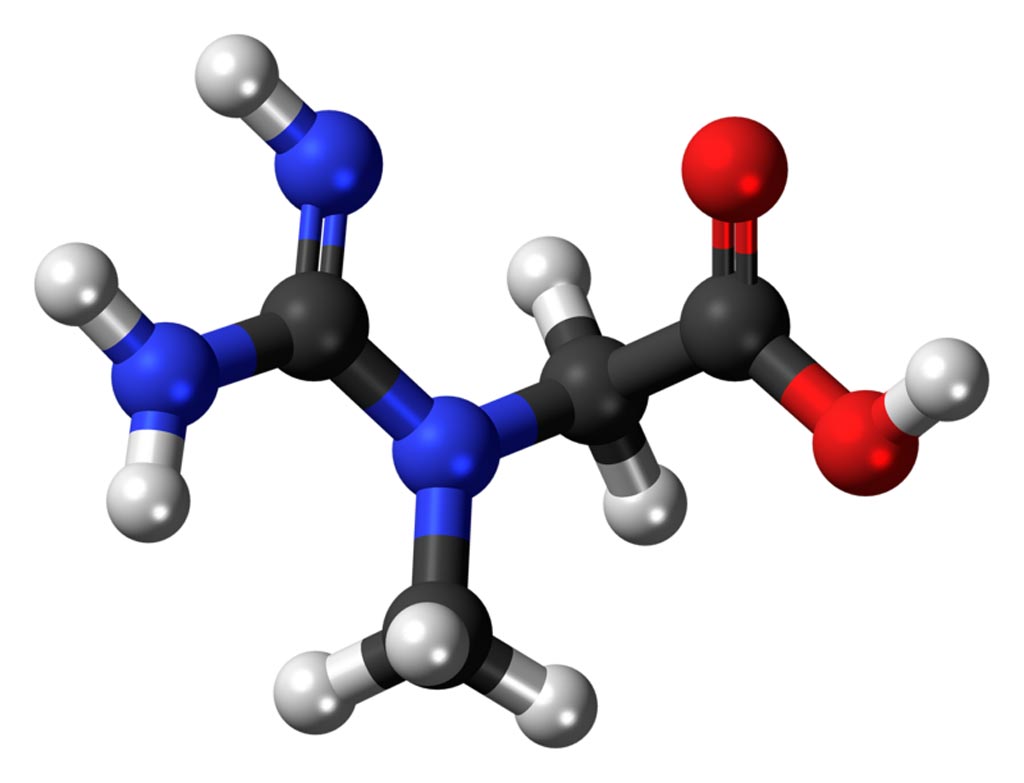Defects in Creatine Metabolism Linked to Inflammatory Bowel Diseases
By LabMedica International staff writers
Posted on 15 Feb 2017
A mutation in the gene that encodes the enzyme glycine amidinotransferase has been linked to the development of inflammatory bowel diseases (IBDs) such as ulcerative colitis and Crohn's disease.Posted on 15 Feb 2017
Glycine amidinotransferase (GATM) catalyzes the rate-limiting step of creatine biosynthesis: the transfer of an amidino group from arginine to glycine to form ornithine and guanidinoacetate. Creatine levels are maintained by diet and endogenous synthesis from arginine and glycine. The compound, which is synthesized mostly in the liver and kidneys, is a nitrogenous organic acid that facilitates recycling of adenosine triphosphate (ATP), primarily in muscle and brain tissue. This is achieved by recycling adenosine diphosphate (ADP) to ATP via donation of phosphate groups.

Image: A ball and stick model of creatine (Photo courtesy of Wikimedia Commons).
Investigators at the University of Texas Southwestern Medical Center screened 36,530 third-generation germline mutant mice for intestinal homeostasis abnormalities after oral administration of dextran sodium sulfate (DSS). Among 27 colitis susceptibility phenotypes identified and mapped, one was strongly correlated with a missense mutation in GATM in a recessive model of inheritance. The link between GATM mutation and the colitis form of IBD was confirmed by CRISPR/Cas9 gene targeting.
CRISPRs (clustered regularly interspaced short palindromic repeats) are segments of prokaryotic DNA containing short repetitions of base sequences. Each repetition is followed by short segments of "spacer DNA" from previous exposures to a bacterial virus or plasmid. CRISPRs are found in approximately 40% of sequenced bacteria genomes and 90% of sequenced archaea. CRISPRs are often associated with cas genes that code for proteins related to CRISPRs. Since 2013, the CRISPR/Cas system has been used in research for gene editing (adding, disrupting, or changing the sequence of specific genes) and gene regulation. By delivering the Cas9 enzyme and appropriate guide RNAs (sgRNAs) into a cell, the organism's genome can be cut at any desired location. The conventional CRISPR/Cas9 system is composed of two parts: the Cas9 enzyme, which cleaves the DNA molecule and specific RNA guides that shepherd the Cas9 protein to the target gene on a DNA strand.
Results published in the January 30, 2017, online edition of the journal Proceedings of the [U.S.] National Academy of Sciences revealed that CRISPR/Cas9-targeted mice displayed a normal peripheral immune response and immune cell homeostasis. However, the intestinal epithelium of these mice displayed increased cell death and decreased proliferation during DSS treatment. In addition, colonocytes from these animals showed increased metabolic stress in response to DSS. These symptoms improved when the mice received creatine in their drinking water, which suggested that creatine was necessary for providing the energy needed for the rapid replenishment of the mucosal barrier and prevention of IBD.
"IBD is a chronic, relapsing, remitting disease in which evidence of healing in the lining of the digestive tract is critical for long-term remission. Current therapy tends to focus on reducing the inflammatory response," said senior author Dr. Bruce Beutler, Nobel Prize winning professor of immunology at the University of Texas Southwestern Medical Center. "However, proper healing of the mucosal layer and cells that line the digestive tract is essential to long-term remission. This study indicates that healing requires effective energy metabolism. The GATM gene is needed for the synthesis of creatine, a substance made in the liver that travels to the barrier cells and allows them to utilize energy in an efficient manner. Mutations in this gene and others needed for mobilization of energy in cells may account for some cases of IBD in humans."













